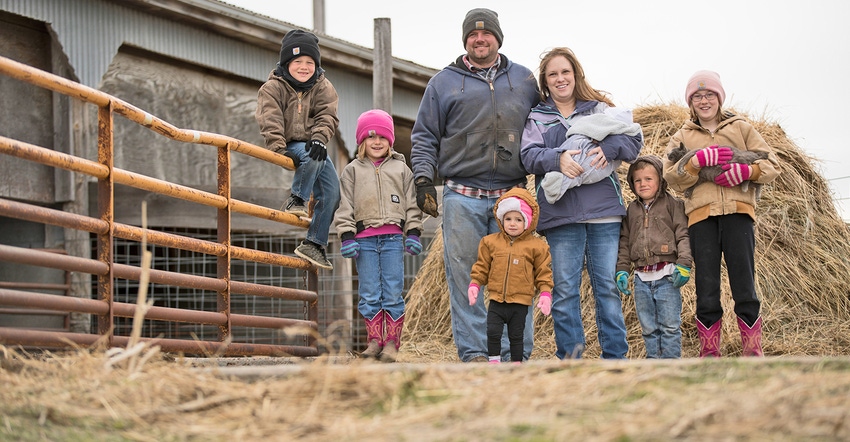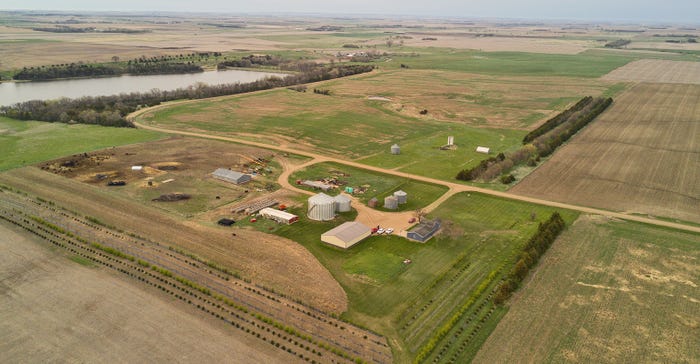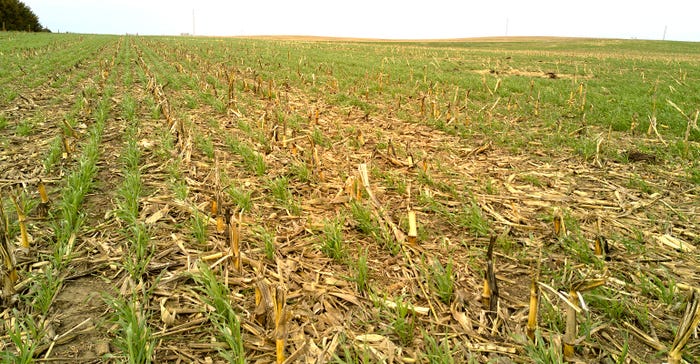
Jordan Reimnitz, Corsica, S.D., started trying cover crops about eight years ago, and now is planting cover crops on 100% of his farmland. He holds down the cost of cover crops six ways.
1. He limits his cover crop to rye. He only mixes in radish, legumes and other species when seeding cover crops after wheat, or when planning to graze the cover crop.
2. He grows his own rye seed.
3. He seeds rye at rates of only 1/2 to 1 bushel per acre. His cover crop seed cost for most fields is just $2-$4 per acre.
4. He sells some of the rye seed he produces if he has more than he needs.
5. He plants cover crops with his no-till air drill. No additional equipment or custom work is needed.
6. He plants rye only after corn and soybean harvest is over. "When I put the combine away for the season, then I get out the drill that will plant cover crop for a week instead of doing tillage," he says. By waiting to plant cover crops until he’s done combining, Reimnitz doesn’t have to hire any extra labor or custom work. Sometimes he doesn’t get any seed planted until November. Although planting a cover crop after August isn’t generally recommended in the Dakotas, Reimnitz farms in the far southern part of South Dakota. November planting has turned out okay, he says. Sometimes there isn’t much, if any, growth on the cover crop in November, but the rye usually takes off quickly in the spring. If spring weather is wet and cool, the rye will be anywhere from 2 feet to 6 feet tall by the time he plants corn or soybeans.
Short term benefits
Reimnitz has seen all the short-term improvements that are typical with cover crops. The soil water infiltration rate appears to have risen. There’s little runoff, even during heavy rain. The soil is holding more moisture. There seems be more biological life in the soil, and the soil structure looks better. When soils are wet, the cover crop roots hold up the tractor and planter better in the spring than bare soil or straight no-till.
Cover crops also have helped him cut winter feed costs for his cows and grow more forage to graze. He’s turned cows out in the fall and spring to graze cover. Grazing didn’t hurt the subsequent grain crop.
 ON HIGH: An aerial view of Jordan Reimnitz's farmland shows the winter lots for cows and the surrounding corn and soybean fields and pasture.
ON HIGH: An aerial view of Jordan Reimnitz's farmland shows the winter lots for cows and the surrounding corn and soybean fields and pasture.

"Cover crops allow me to get cows out of the lot early, get them grazing and let the grass in the pastures get going a little better in the spring," he says.
Long-term goals
One of Reimnitz’s long-term goals with cover crops is to build a more resilient soil — one that will produce a crop whether it is excessively wet or dry. He hopes that in the one or two years out of 10 in his area when crops fail due to drought or excessive rain, he will produce an average or above-average yield.
Reimnitz, 34, also hopes to leave the soil in better shape than when he started farming it.
"I want to improve things long-term. If it’s not for one of my kids, hopefully it’s for someone who has the same philosophy about the soil that I do," he says.
 AFTER CORN: Rye seedlings grow in corn stubble on Jordan Reimnitz's farm.
AFTER CORN: Rye seedlings grow in corn stubble on Jordan Reimnitz's farm.

To watch a South Dakota Soil Health Coalition video interview with Reimnitz see sdsoilhealthcoalition.org/videos/. For more information about cover crops and soil health, contact the South Dakota Health Coalition at 605-280-4190 or see [email protected].
Kara Pugsley, a writer for The South Dakota Soil Health Coalition, contributed to this article.
About the Author(s)
You May Also Like






